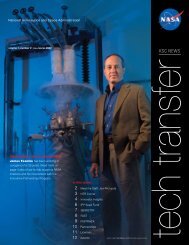2006-2007 - Kennedy Space Center Technology Transfer Office
2006-2007 - Kennedy Space Center Technology Transfer Office
2006-2007 - Kennedy Space Center Technology Transfer Office
- No tags were found...
You also want an ePaper? Increase the reach of your titles
YUMPU automatically turns print PDFs into web optimized ePapers that Google loves.
160VOC Removed (%) (i.e., 100–C exit/C in×100)9070503010DichloromethaneEthanolAcetaldehydeTolueneAverage CO 2Conversion (%)1208040a–100 10 20 30 40 50 60 70Time After UV Lamp On (min)DCM Toluene Ethanol AcetaldehydeFigure 2. Photocatalytic oxidation of a constant flow (0.2 L/min) of 100 ppm toluene, dichloromethane, acetaldehyde, and500 ppm ethanol; (a) VOC removed upon single pass through PCO cell; and (b) corresponding CO 2formation.b0Photocatalytic oxidation (PCO) of organic pollutants consumes less power, uses a nontoxic catalyst, andcan destroy most organic pollutants. This technology has been employed in air revitalization systems.However, it is not known whether organic compounds are stoichiometrically oxidized into carbon dioxide.The concept of using PCO for TOC determination was tested. A prototype PCO cell (Figure 1) wasconstructed and evaluated against four VOCs representing alcohol, aldehyde, aromatic, and halogeniccompounds. Representative results are summarized in Figure 2. Ethanol and acetaldehyde were oxidizedalmost completely upon single pass through the PCO cell, as is evident by the low level of starting materialin PCO cell effluent and the formation of carbon dioxide at 100 percent of the theoretical conversion.However, the percentages of toluene and dichloromethane oxidized were about 80 and 50 percentinitially and declined over time. This decreased oxidation may be attributed to the formation of intermediatesthat compete for the active site on the titanium dioxide catalyst. Over 50 minutes, the carbondioxide conversion efficiency (i.e., actual [carbon dioxide]/expected [carbon dioxide] × 100) was about40 and 20 percent for toluene and dichloromethane, respectively. The effect of linear velocity and surfacearea on the oxidation efficiency was also examined. Based on these preliminary results, a new PCO cellwith improved performance was designed and is under construction.We plan to couple this PCO cell with a commercial off-the-shelf (COTS) encoded photometric infrared(EP-IR) spectrometer to provide early detection of harmful VOCs and equipment leaks and to monitorthe efficacy of air revitalization and solid-waste management systems. This dual-function sensor isportable and reagent-free, has no consumables, and is ideal for field application.The project demonstrated stoichiometric conversion of select VOCs (e.g., ethanol and acetaldehyde) intocarbon dioxide, implying the feasibility for PCO of VOCs as an alternative means for TOC measurement.Furthermore, a COTS EP-IR was acquired as our sensing component.Contact: Dr. John C. Sager , NASA-KSC, (321) 861-2949Participating Organizations: Dynamac Corporation (Dr. Lanfang H. Levine, William A. Rigdon, and Patricia A.Bisbee), NASA-KSC (Dr. Paul E. Hintze), and University of Delaware (Dr. Karl S. Booksh and Dr. Yoon-Chang Kim)KSC <strong>Technology</strong> Development and Application <strong>2006</strong>-<strong>2007</strong>123/124













